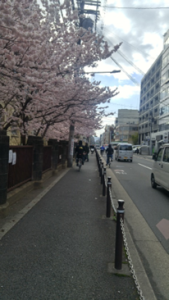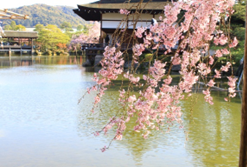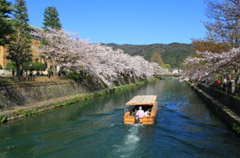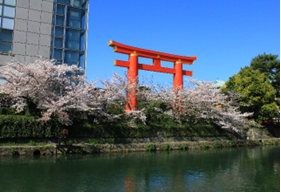The cherry blossom front is a signal for rice cultivation Princess Konohana no Sakuya As of March 13th, spring cherry blossoms are in full bloom.
Yoshie Doi
 |
 Taken on March 13, 2023 Seitoku Junior High School Site Takatsuji Dori Muromachi Nishiiri Every spring, Harumeki cherry are the earliest Kyoto’s cherry blossoms. Taken on March 13, 2023 Seitoku Junior High School Site Takatsuji Dori Muromachi Nishiiri Every spring, Harumeki cherry are the earliest Kyoto’s cherry blossoms. |
 Weeping cherry tree at Heian Shrine |
 Canal cherry blossoms |
 Heian Shrine torii and cherry blossoms Heian Shrine torii and cherry blossoms |
On March 13, 2023, the spring cherry blossoms were in full bloom at the former site of Motoseitoku Junior High School, west of Takatsuji Karasuma. Every year, it reaches full bloom early. This year, the temperature in early March has risen, so the cherry blossoms are already in full bloom.
The flowering specimen tree of cherry blossoms in Kyoto is a specimen tree in Nijo Castle. The average year is March 26th. Last year it was 24th, the earliest in 2021 was March 16th, and the latest was April 9th, 1984. Kyoto is also expected to bloom early this year.
The cherry blossoms in the photo were taken about 10 years ago when the Kyo-Suzume school was held. It is also a place where I did fieldwork in several cherry blossom courses. Sometimes, I remember well the time when it was held in the cold April after the rain. Also, although there are no lights on the Philosopher’s Path along the canal, the cherry blossom viewing at night, where each person walks with their flashlights pointed at the sky, is a pleasant memory. It was an annual cherry blossom viewing event with a group of about 20 people.
Recently, I learned that cherry blossoms have been blooming in spring since the Jomon period. Moreover, it is said that shurizakura and uwamizuzakura bloomed in the north, wild cherry blossoms and Edohigan cherry blossoms bloomed in the south, and Oyamazakura bloomed even in heavy snowfall areas.
In the “Kojiki” and “Nihon Shoki”, she is described as Konohana no Sakuya Hime, and originally the cherry blossoms blooming beautifully in the mountains were called “Sakuya”. It seems to have been transformed into Sakura
Since ancient times in Japan, cherry blossoms have been used as a guideline for agriculture. Even now, the Uomizakura in Oita Prefecture, the Asamakizakura in Hyogo Prefecture, and the Tanemakizakura in Iwate Prefecture are still in bloom and serve as indicators for agriculture. I often see scenery where one cherry tree is planted in a rice field. I think it’s to tell us about farm work. The reason why many cherry trees are planted along the banks of rivers is that their roots extend over a wide area, so they can be used to reinforce the banks. This year, why don’t you think about the wisdom of the old people and enjoy cherry blossom viewing.
In ancient Japan, it was thought to be a harbinger of a god who normally lives in the mountains descending from a mountain village to a human village. It was written as “Saza” and read as “Sakura”, and Saza means the god of the mountains (the god of grain), and it was thought that it served as a calendar to tell that it was time to plant rice when the cherry blossoms were in full bloom.
In ancient times, when people crossed a mountain pass, they put their hands together and thanked the god of the mountain for their safety. Therefore, the hand gesture became “tamuke”, and “tauge” changed to the word “touge”. increase. The word “Shagamu” is thought to be a modified form of “saogamu” and was born from the posture of worshiping a god.
It was customary to offer sake and fish to Sagami under the cherry blossom tree, where Sagami relies, and receive a hand-me-down of sake and feasts under the cherry blossoms. Also, just making an offering is not enough, so I started singing songs and watching dedication dances. The seat for the honored guests of the sagami was the box, and the common people watched it on the grass on the ground, so the word “shibai” was born.
The end of document
